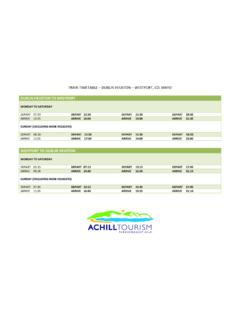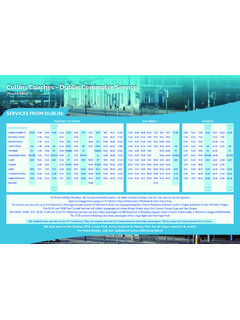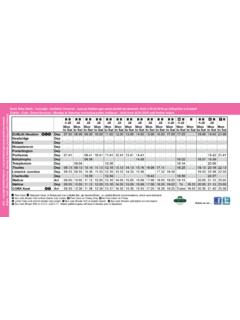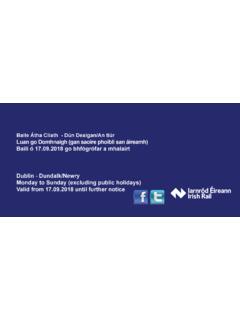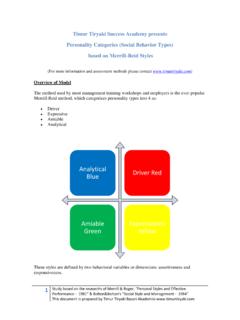Transcription of Big Data Uses for Risk Assessment in Predictive Outage and ...
1 Big Data Uses for Risk Assessment in Predictive Outage and asset management M. Kezunovic, T. Dokic, P. Chen Texas A&M UniversitySUMMARY Allowing better estimates of the risk associated with outages and asset failures is an ultimate goal since the cost of service interruption due to forced or planned Outage can be substantial. This paper address how the risk calculation is improved by the use of Big Data related to weather and other environmental impacts that may lead to outages and asset deterioration.
2 Big Data considered in this paper relates to various weather data services such as radar, satellite, land stations, specialized tracking systems (lightning), etc., as well as vegetation and topography. In addition, traditional utility measurement data coming from Intelligent Electronic Devices located in substations and along the feeders are integrated to get better Assessment of the risk. Developing a framework that ties the data and physical network components together in time and space to obtain better predictions is an emerging area of research.
3 Our innovative study opens several opportunities to address unique fundamental issues of how to effectively fuse weather and network data in time and space for the benefit of predicting likelihood of power network outages under severe weather conditions, which will lead to better maintenance and operation strategies. The results are obtained using advanced Predictive data analytics approach that incorporates spatiotemporal properties of the Big Data. To better visualize the risk Assessment results, a Geographic Information System view of the power system components is offered.
4 This view allows operators to immediately assess the risk in the face of unfolding weather conditions and take actions accordingly. The benefits of using Big Data to achieve such decision-making capability is contrasted with the legacy solutions and their mostly after-the-fact reactive actions. The Big Data utilization is part of a larger effort aimed at introducing various advantages to the utility industry based on the advanced data analytics. Several examples from the recent work done for the utility industry are given, using a real life representation of their system and the associated events.
5 KEYWORDS asset management , big data, Outage management , risk analysis, tree trimming, vegetation management , weather impact. 21, rue d Artois, F-75008 PARIS Type here your Paper reference DUBLIN 2017 http : (to be centred) 1 Figure 1. Overall Implementation Description 1. INTRODUCTION The efficiency of implementing Outage and asset management has a significant impact on the reliability and cost of utility operations. Weather conditions are very important in determining the power system operating conditions including the state of assets, and probability of outages [1].
6 Each type of weather-related event has a different impact on the power system. Differentiating between weather events and using the appropriate granularity of weather-related data in the prediction process is a critical component of a successful strategy to manage and mitigate the impacts. Previous studies have focused on the predictions of hurricanes (tropical cyclones) and the resultant power outages . Guikema et al. [2] developed models to estimate the physical damage of a hurricane to power systems.
7 Liu et al. [3] developed models to estimate the restoration times for hurricanes and ice storms related outages . Davidson et al. [4] studied outages caused by hurricanes and concluded that the relationship between the maximum wind gust and the number of outages is statistically significant. Nateghi et al. [5] examined various statistical models for estimating Outage durations and validated the Predictive power of these models. Quiring et al. [6] incorporated uncertainties in the hurricane forecast into Outage modeling.
8 Han et al. [7] developed statistical models to estimate the number of outages in grid cells of a utility service area in the gulf coast region for an approaching hurricane. In summary, Ref. [2-7] have studied Outage predictions and durations by statistical models. Shariatinasab et al. present optimal location method for surge arresters based on statistical analysis of insulation characteristics [8]. Orille-Fern ndez et. all use artificial neural networks to estimate risk of failure for lightning protection equipment [9].
9 In [10], Meliopoulos et al. present the overvoltage protection method based on Monte-Carlo analysis. In [11], Amarh et al. discuss a statistical method for insulator risk Assessment used for prediction of flashover occurrences. The work in [12] predicts insulator flashover voltage based on the voltage surface resistance measurement. Previous studies [8-13] assumed constant insulator strength through the lifetime, and neglected insulator individual spatial and temporal characteristics.
10 Same as in case of Outage management , the conventional studies of insulation coordination are based on statistical models. In contrast to previous studies based mainly on statistical modelling, this paper describes the development of a Predictive decision making tools for utilities based on data mining. The outages and assets deterioration for variety of weather events, including seasonal events (thunderstorms, tornados), extreme daily variations (temperature, wind, precipitation), and catastrophic events (hurricanes, tornados) can be better managed by predicting the impacts.


